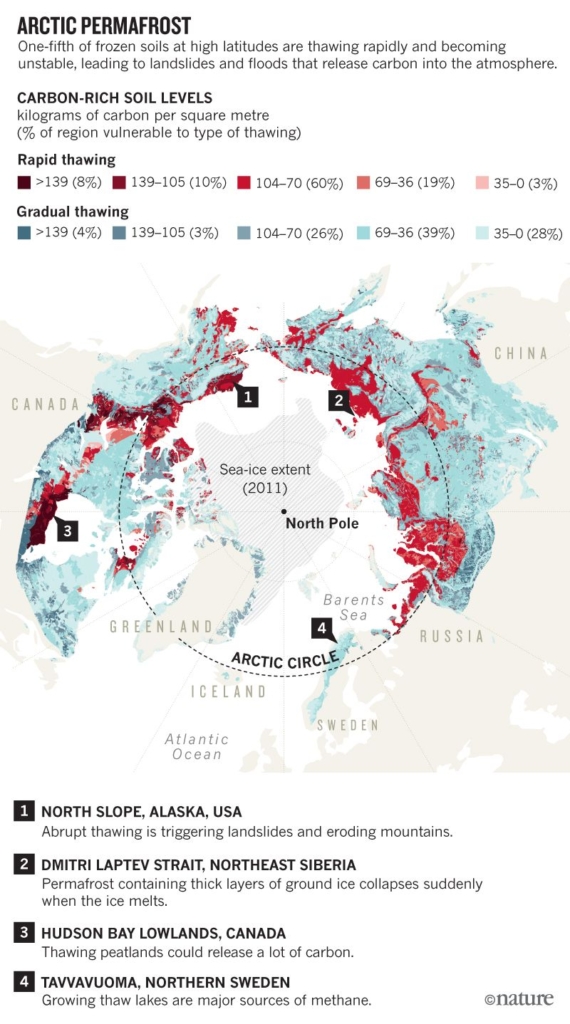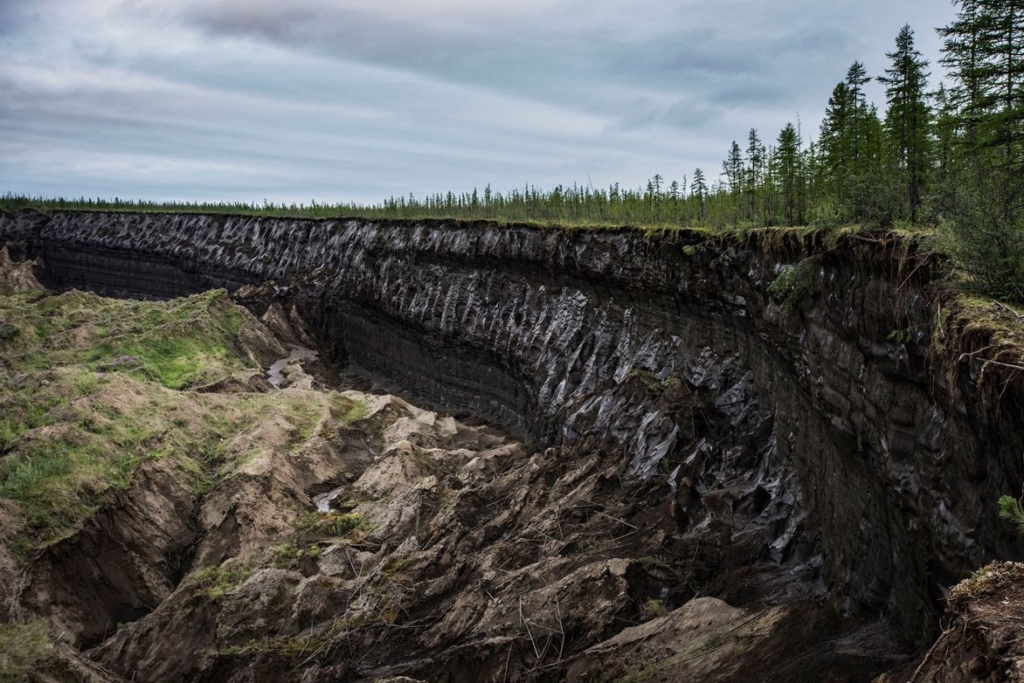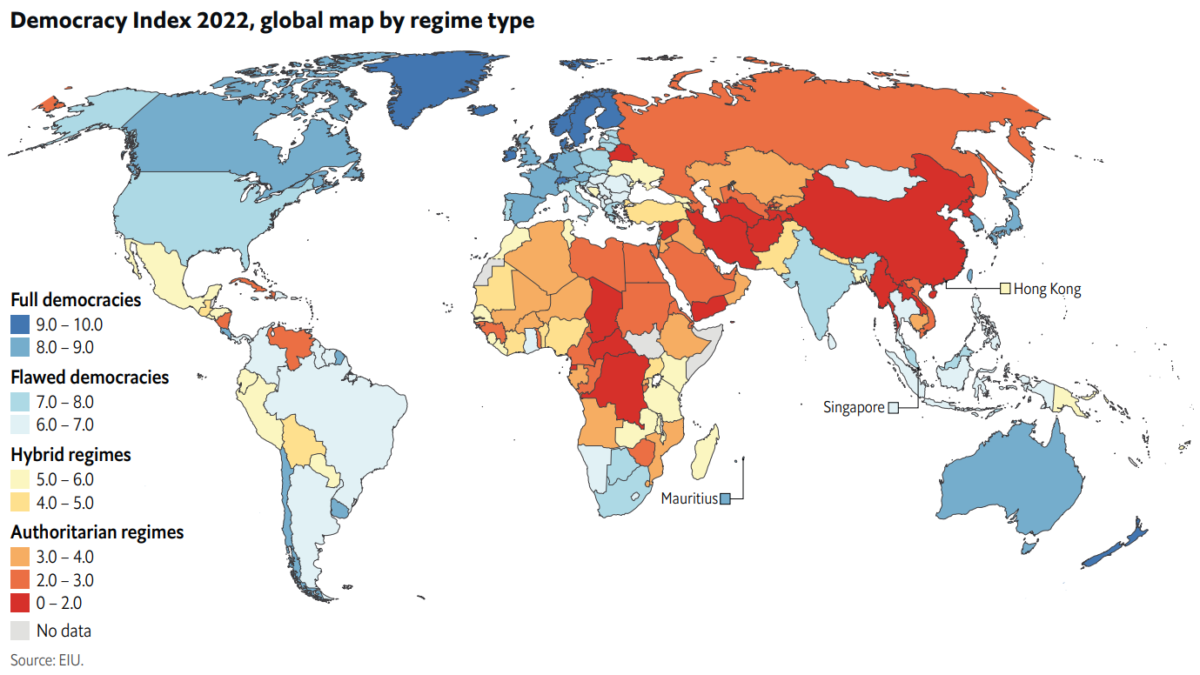Rapid permafrost thaw unrecognized threat to landscape, global warming researcher warns – “We are watching this sleeping giant wake up right in front of our eyes”

30 April 2019 (University of Guelph) – A “sleeping giant” hidden in permafrost soils in Canada and other northern regions worldwide will have important consequences for global warming, says a new report led by University of Guelph scientist Merritt Turetsky.
Scientists have long studied how gradual permafrost thaw occurring over decades in centimetres of surface soils will influence carbon release to the atmosphere. But Turetsky and an international team of researchers are looking at something very different: rapid collapse of permafrost that can transform the landscape in mere months through subsidence, flooding and landslides.
“We are watching this sleeping giant wake up right in front of our eyes,” said Turetsky, who holds the Canada Research Chair in Integrative Ecology.
The team discusses the importance of abrupt thaw for carbon release estimates, northern ways of living and climate policy in a commentary in the 2 May 2019 issue of Nature. The researchers put together results from abrupt thaw studies from a range of environments across the permafrost zone to estimate the overall effect.
Permafrost affects about one-quarter of land in the northern hemisphere. These frozen soils lock up carbon in biomass from dead plants, animals and microbes over millennia, preventing its breakdown and keeping it out of the atmosphere. As a result, permafrost region soils now hold twice as much carbon – about 1.6 trillion tonnes — as is contained in the atmosphere.
“We work in areas where permafrost contains a lot of ice, and our field sites are being destroyed by abrupt collapse of this ice, not gradually over decades, but very quickly over months to years,” said Turetsky.
Co-author Miriam Jones, a United States Geological Survey research geologist, said: “This abrupt thaw is changing forested ecosystems to thaw lakes and wetlands, resulting in a wholesale transformation of the landscape that not only impacts carbon feedbacks to climate but is also altering wildlife habitat and damaging infrastructure.”
Describing the formation of thaw lakes and landslides triggering mass movement of soil and sediment into rivers and streams, Turetsky adds: “It’s happening faster than anyone predicted. We show that abrupt permafrost thawing affects less than 20 per cent of the permafrost region, but carbon emissions from this relatively small region have the potential to double the climate feedback associated with permafrost thawing.”
Unlike gradual thaw that affects mostly the surface and penetrates the ground slowly, abrupt permafrost thawing disrupts deeper carbon stockpiles more rapidly. In addition, abrupt thaw releases more methane — a stronger greenhouse gas than carbon dioxide — than does gradual thaw.
In their paper, the team calls for more measurement and monitoring of Arctic permafrost, as well as improved modelling and reporting of effects of thaw on climate.
University of Alaska Fairbanks emeritus professor Dave McGuire said, “There is an urgent need to make substantive progress on representing the effects of abrupt thaw on the carbon cycle in Earth system models. This will inform policy-makers about how the release of carbon from abrupt thaw may affect the implementation of carbon management strategies to control the growth of greenhouse gases in the atmosphere.”
The researchers say rapid permafrost collapse will have local, national and international effects, from altering traditional travel and hunting patterns in the North, to causing costly infrastructure damage to roads and rail lines, to making it even more difficult to meet emission targets intended to limit global warming.
Despite threats to northern permafrost and climate, Turetsky remains optimistic.
“If we can limit human emissions, we can still curb the most dangerous consequences of climate warming. Our window for action is getting narrow, but we still have it and can make changes to save the Arctic as we know it, and the Earth’s climate along with it.”
Ted Schuur, professor at Northern Arizona University, said, “Synthesis science designed to bring ideas and people together to create new knowledge is critical for understanding abrupt thaw impacts across the permafrost region at the scale where it affects climate.”
Contact
- Prof. Merritt Turetsky, mrt@uoguelph.ca
- Lori Bona Hunt, Director, News Service, 519-824-4120, Ext. 53338, lhunt@uoguelph.ca
- Deirdre Healey, Manager, News Service, 519-824-4120, Ext. 56581, healeyd@uoguelph.ca
Rapid Permafrost Thaw Unrecognized Threat to Landscape, Global Warming Researcher Warns

Permafrost collapse is accelerating carbon release
30 April 2019 (Nature) – This much is clear: the Arctic is warming fast, and frozen soils are starting to thaw, often for the first time in thousands of years. But how this happens is as murky as the mud that oozes from permafrost when ice melts.
As the temperature of the ground rises above freezing, microorganisms break down organic matter in the soil. Greenhouse gases — including carbon dioxide, methane and nitrous oxide — are released into the atmosphere, accelerating global warming. Soils in the permafrost region hold twice as much carbon as the atmosphere does — almost 1,600 billion tonnes1.
What fraction of that will decompose? Will it be released suddenly, or seep out slowly? We need to find out.
Current models of greenhouse-gas release and climate assume that permafrost thaws gradually from the surface downwards. Deeper layers of organic matter are exposed over decades or even centuries, and some models are beginning to track these slow changes.
But models are ignoring an even more troubling problem. Frozen soil doesn’t just lock up carbon — it physically holds the landscape together. Across the Arctic and Boreal regions, permafrost is collapsing suddenly as pockets of ice within it melt. Instead of a few centimetres of soil thawing each year, several metres of soil can become destabilized within days or weeks. The land can sink and be inundated by swelling lakes and wetlands.
Abrupt thawing of permafrost is dramatic to watch. Returning to field sites in Alaska, for example, we often find that lands that were forested a year ago are now covered with lakes2. Rivers that once ran clear are thick with sediment. Hillsides can liquefy, sometimes taking sensitive scientific equipment with them.
This type of thawing is a serious problem for communities living around the Arctic (see ‘Arctic permafrost’). Roads buckle, houses become unstable. Access to traditional foods is changing, because it is becoming dangerous to travel across the land to hunt. Families cannot reach lines of game traps that have supported them for generations.
In short, permafrost is thawing much more quickly than models have predicted, with unknown consequences for greenhouse-gas release. Researchers urgently need to learn more about it. Here we outline how.[more]


